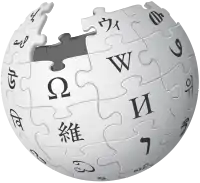interrobang
See also: Interrobang
English
WOTD – 10 February 2017

an interrobang
Etymology
A blend of Latin interrogātiō (“examination, inquiry, interrogation, questioning”) + bang (“exclamation mark, exclamation point”), coined in a 1962 article in the journal TYPEtalks[1] by American advertising executive Martin K. Speckter (1915–1988), who invented the symbol.[2]
Pronunciation
- (Received Pronunciation) IPA(key): /ɪnˈtɛ.ɹəʊˌbæŋ/
- (General American) enPR: ĭn.tĕrʹə.băng', IPA(key): /ɪnˈtɛ.ɹəˌbæŋ/
- (Standard Canadian) IPA /ɪnˈtɛ.ɹɔˌbæŋ/
- Hyphenation: in‧ter‧ro‧bang
Noun
interrobang (plural interrobangs)
- The nonstandard punctuation mark ‽ (a combination of ? and !), which may be used at the end of a sentence to express excitement or disbelief, or to indicate that it is a rhetorical question. [from 1962.]
- 1968 November 15, William Zinsser, “For clear expression: Try words: The interrobang”, in Life, volume 65, number 20, Chicago, Ill.; New York, N.Y.: Time Inc., ISSN 0024-3019, OCLC 34142982, page 24:
- Has anyone seen an interrobang? It's a newly invented punctuation mark that looks like this: ‽ A question mark with an exclamation point superimposed, it's meant to convey that nuance of feeling—a mixture of query and surprise—that people have in mind when they say "Really?", also meaning "Really!", or "How about that‽" […] The cure for incredibility is not more punctuation, but more plain talk. We don't need symbols like the interrobang that merely express our perpetual disbelief. We need plain words to express plain truths.
- 2011 September, Simon Garfield, “Breaking the Rules”, in Just My Type: A Book About Fonts, New York, N.Y.: Gotham Books, Penguin Group, →ISBN, page 268:
- The Interrobang is not a font – just a single character. Yet it is so powerful a symbol, and such a flawed and original concept, that it deserves a place alongside the most adventurous typographic innovations of the last century. It is an exclamation mark and a question mark combined, a ligature looping the curve of the interrogation with the downward force of the expletive (which compositors and printers have traditionally called a bang). When they meld, they need only one round point at their base.
- 2013, Keith Houston, “The Interrobang”, in Shady Characters: The Secret Life of Punctuation, Symbols & Other Typographical Marks, New York, N.Y.: W. W. Norton & Company, →ISBN, pages 28–29:
- Popular as it was with writers and admen, the interrobang faced a struggle for mainstream acceptance. Simulating an interrobang on a typewriter was possible, if clumsy—type "?" and then overstrike it with "!"—but for typesetters creating a printed document, there was no such shortcut. Those advertisements, brochures, and books that actually honored the writer's use of the character had to be set using handcrafted interrobangs, either drawn by an illustrator or sculpted from rubber cement with a razor blade.
- 2014, John Senior, “Idea 79: The Interabang!?”, in 100 Ideas for Secondary Teachers: Gifted and Talented, London: Bloomsbury Education, Bloomsbury Publishing, →ISBN, page 94:
- Introduce the notion of combining punctuation marks in new ways. Explain the Interabang and its use as a nonstandard punctuation mark intended to combine the functions of the question mark and the exclamation mark. Allowing your students the use of all keyboard symbols to create additional punctuation forms, what other punctuation combinations would prove useful in allowing greater expression through punctuation?
-
Alternative forms
Derived terms
Translations
the punctuation mark ‽
|
|
See also
- dashes ( ‒ ) ( – ) ( — ) ( ― )
- ellipsis ( … )
- exclamation mark ( ! )
- fraction slash ( ⁄ )
- guillemets ( « » )
- hyphen ( - ) ( ‐ )
- interpunct ( · )
- interrobang (rare) ( ‽ )
- parentheses ( ( ) )
- period (US) or full stop (UK) ( . )
- question mark ( ? )
- quotation marks (formal) ( ‘ ’ ) ( “ ” )
- quotation marks (informal, Computing) ( " ) ( ' )
References
- Martin K. Speckter (March–April 1962), “Making a new point, or, how about that …”, in TYPEtalks: see Keith Houston (2013), “The Interrobang”, in Shady Characters: The Secret Life of Punctuation, Symbols & Other Typographical Marks, New York, N.Y.: W. W. Norton & Company, →ISBN, pages 25–28.
- “Martin K. Speckter, 73, creator of interrobang”, in The New York Times, 16 February 1988, archived from the original on 20 March 2016, retrieved 20 December 2016.
- “Interrobang” in Michael Quinion, World Wide Words, created 7 April 2001, last updated 3 April 2010.
Further reading

Portuguese
Etymology
Borrowed from English interrobang. See there for further details.
Pronunciation
- (Portugal) IPA(key): /ĩtɛʁuˈbɐ̃ɡɨ/
This article is issued from Wiktionary. The text is licensed under Creative Commons - Attribution - Sharealike. Additional terms may apply for the media files.